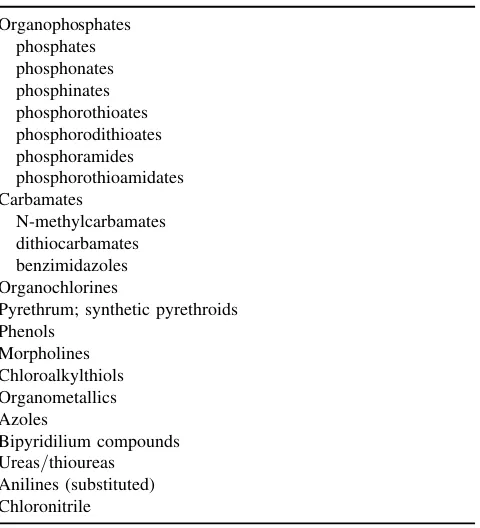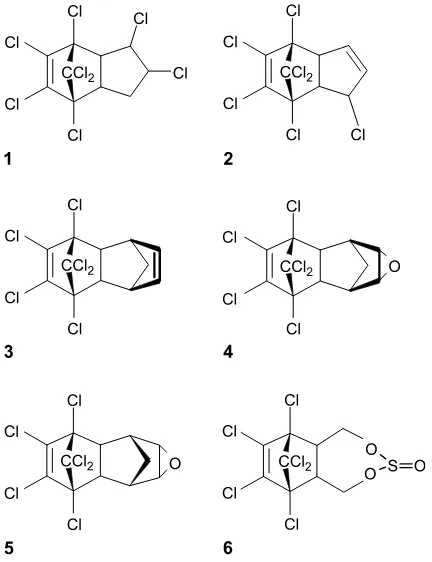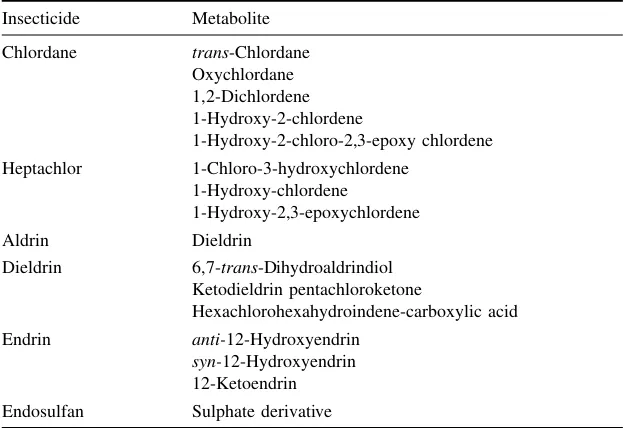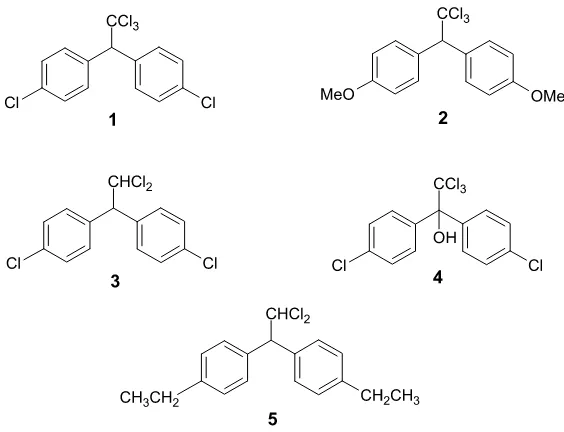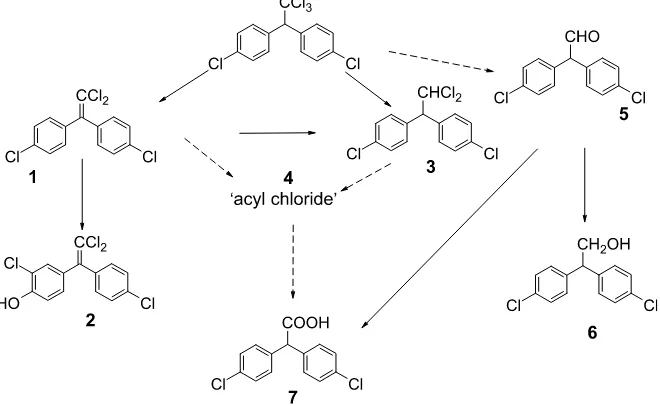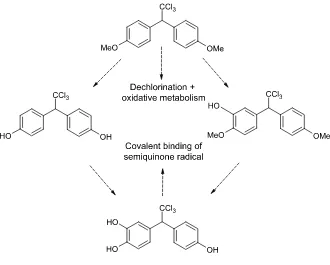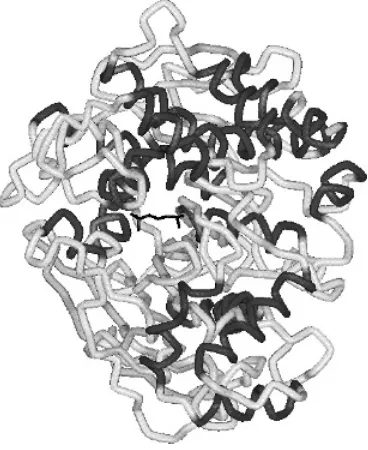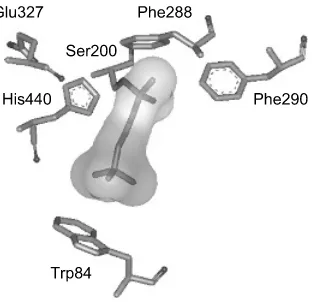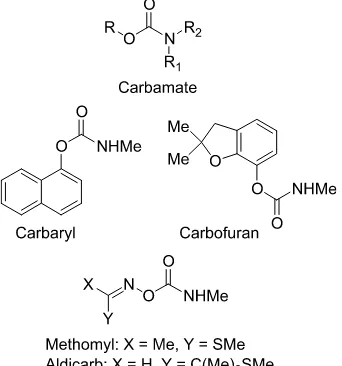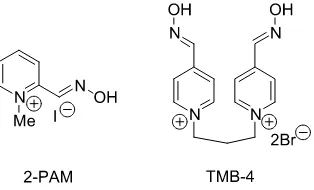Pesticide Toxicology
and International Regulation
Current Toxicology Series
Series Editors
Diana Anderson Michael D Waters Timothy C Marrs
Department of Consultant Food Standards Agency
Biomedical Sciences Chapel Hill London, UK University of Bradford, UK NC, USA
Toxicology is now considered to be a topic worthy of study and research in its own right, having originally arisen as a subsection of pharmacology. This rapid growth in the significance of toxicology necessitates specialised yet comprehensive information that is easily accessible both to professionals and to the increasing number of students with an interest in the subject area.
Comprising professional and reference books, primarily aimed at an academic= industrial=professional audience, theCurrent Toxicology Series covers a variety of ‘core’ toxicology topics, suitable for use both as an updating tool and as a reference source.
Published titles
Nutrition and Chemical Toxicity
Edited by C. Loannides (0 470 974453 0)Toxicology of Contact Dermatitis: Allergy, Irritancy and Urticaria
Edited by D. Basketter, F. Gerberick, I. Kimber and C. Willis (0 471 97201 0)Food Borne Carcinogens: Heterocyclic Amines
Edited by M. Nagao and T. Sugimura (0 471 98399 3)
Enzyme Systems that Metabolise Drugs and Other Xenobiotics
Edited by C. LoannidesPesticide Toxicology and International Regulation
Pesticide Toxicology
and International Regulation
Edited by
Timothy C. Marrs
Food Standards Agency, London, UK
and
Bryan Ballantyne
Formerly, Director of Applied Toxicology,
Union Carbide Corporation, Connecticut, USA;
Adjunct Professor, Department of Pharmacology
and Toxicology, West Virginia University, USA;
Adjunct Professor of Toxicology,
Copyright#2004 by John Wiley & Sons Ltd, The Atrium, Southern Gate, Chichester, West Sussex PO19 8SQ, England
Telephone (þ44) 1243 779777
E-mail (for orders and customer service enquiries): cs-books@wiley.co.uk Visit our Home Page on www.wileyeurope.com
or www.wiley.com
All Rights Reserved. No part of this publication may be reproduced, stored in a retrieval system or transmitted in any form or by any means, electronic, mechanical, photocopying, recording, scanning or otherwise, except under the terms of the Copyright, Designs and Patents Act 1988 or under the terms of a licence issued by the Copyright Licensing Agency Ltd, 90 Tottenham Court Road, London W1T 4LP, UK, without the permission in writing of the Publisher. Requests to the Publisher should be addressed to the Permissions Department, John Wiley & Sons Ltd, The Atrium, Southern Gate, Chichester, West Sussex PO19 8SQ, England, or emailed to permreq@wiley.co.uk, or faxed to (þ44) 1243 770620.
This publication is designed to provide accurate and authoritative information in regard to the subject matter covered. It is sold on the understanding that the Publisher is not engaged in rendering professional services. If professional advice or other expert assistance is required, the services of a competent professional should be sought.
Other Wiley Editorial Offices
John Wiley & Sons Inc., 111 River Street, Hoboken, NJ 07030, USA
Jossey-Bass, 989 Market Street, San Francisco, CA 94103-1741, USA
Wiley-VCH Verlag GmbH, Boschstr. 12, D-69469 Weinheim, Germany
John Wiley & Sons Australia Ltd., 33 Park Road, Milton, Queensland 4064, Australia
John Wiley & Sons (Asia) Pte Ltd., 2 Clementi Loop #02-01, Jin Xing Distripark, Singapore 129809
John Wiley & Sons Canada Ltd., 22 Worcester Road, Etobicoke, Ontario, Canada M9W 1L1
Wiley also publishes its books in a variety of electronic formats. Some content that appears in print may not be available in electronic books.
British Library Cataloguing in Publication Data
A catalogue record for this book is available from the British Library ISBN 0 471 49644 8
Typeset in 10=12pt Times by Thomson Press (India) Ltd., Chennai
Printed and bound in Great Britain by Antony Rowe Ltd., Chippenham, Wilts
Contents
Preface
xi
List of Contributors
xv
Frequently Used Abbreviations
xvii
Toxicity Classifications and Hazard Ratings
xxiii
1 Pesticides: An Overview of Fundamentals
1
Bryan Ballantyne and Timothy C. Marrs
Definition and introductory generalizations 1
Major historical features 2
Classification and nomenclature 3
Exposure to pesticides; routes, monitoring, and protection 5
Health issues 9
Regulation of pesticides 16
References 19
Part I Insecticides
2 Toxicology of Organochlorine Insecticides
27
Andrew G. Smith
Overview 27
Lindane=hexachlorocyclohexane (HCH) 32
Cyclodiene and related insecticides 39
Toxaphene 45
DDT and its analogues 46
DDT 48
Mirex and chlordecone 59
Regulatory aspects 64
Summary 65
References 65
3 Anticholinesterase Insecticides
89
Charles M. Thompson and Rudy J. Richardson
Introduction 89
Major classes of anti-AChE insecticides 95 Toxicological consequences of AChE inhibition 107
Therapy for cholinergic toxicity 108
Regulatory aspects of anti-AChE insecticides 110
Acknowledgements 117
References 118
4 Toxicology of Pyrethrins and Synthetic Pyrethroids
129
David E. Ray
Usage and human exposure 129
Mechanisms of toxicity 131
Systemic poisoning 139
Pathology 144
Paraesthesia and local irritation 145
Developmental neurotoxicity 146
Reference values for synthetic pyrethroids 147
References 149
5 Toxicology of Miscellaneous Insecticides
159
Roland Solecki
Introduction 159
Neuroactive insecticides 161
Insect growth regulators 174
Plant insecticides 180
Biochemical insecticides 185
References 186
Part II Fungicides, Herbicides and Growth Regulators
6 Toxicology of Fungicides
193
Bryan Ballantyne
Introduction 193
Halogenated substituted monocyclic aromatics 196
Dithiocarbamate fungicides 217
Dithiocarbamates 217
Ethylene bisdithiocarbamates 225
Benzimidazole=thiabendazole fungicides 231
Chloroalkylthiodicarboximides 242
Azoles 248
Morpholines 261
Carboxanilides (oxathiins) 265
Organophosphates 268
Piperazines 271
Metallic fungicides 272
Miscellaneous 274
Aliphatic aldehydes 274
Thiocarbonates 278
Antibiotics 279
Cinnamic acid class 281
Appendix: Complete listing of fungicides by chemical classes 282
References 292
7 Toxicology of Herbicides
305
Timothy C. Marrs
Herbicides 305
Inorganic herbicides 305
Bipyridylium herbicides 305
Phenoxy acid herbicides 320
Substituted anilines 327
Ureas and thioureas 328
Nitriles 329
Triazines and triazoles 329
Organic phosphorus herbicides 331
Defoliants and dessicants, and plant growth regulators 334
References 334
Part III Special Types of Pesticide
8 Microbial Pesticides
349
Ian C. Dewhurst
Introduction 349
Regulatory approaches 351
Toxicity of particular organisms 353
References 361
9 Biocides
365
Bryan Ballantyne and Susan L. Jordan
Introduction 365
Chemistry of biocides 367
2,2-Dibromo-3-nitrilopropionamide (DBNPA) 368
Methylenebisthiocyanate (MBT) 371
Quarternary ammonium compounds (quats) 372
2-Bromo-2-nitropropane-1,3-diol (bronopol; BNP) 375
iso-Thiazolones 377
Tetra-(hydroxymethyl)-phosphonium sulphate (THPS) 384
Peracetic acid (PAA) 385
Glutaraldehyde (GA) 388
Part IV Residues
10 Variability of Residues in Unprocessed
Food Items and its Impact on Consumer
Risk Assessment
413
Caroline A. Harris and Alan R. C. Hill
Variability of pesticide residues 413
Maximum residue limits 414
Minor crops 415
Derivation of MRLs 415
Discovery of residue variability in UK crops 416
Further studies on variability 417
Implications of variability and derivation
of the variability factor 418
Calculation of acute dietary exposure 419
Refinement of the variability factor 422
Consumption data in assessing acute dietary exposure 423 Toxicology in the derivation of an acute reference dose 424
Calculating consumer exposure 425
The impact on availability of pesticides 426
References 426
Part V Human Aspects
11 Occupational Aspects of Pesticide
Toxicity in Humans
431
Angelo Moretto
Occurrence of occupational pesticide poisoning 431 Acceptable occupational exposure levels (AOELs)
and estimate of levels of pesticide exposure 432 Generalities on biological monitoring of pesticide exposure 435 Toxicological effects of occupational exposure to pesticides 436
References 458
12 Treatment of Pesticide Poisoning
473
Gregory P. Wedin and Blaine E. Benson
Introduction 473
General treatment guidelines 473
Insecticides 476
Herbicides 481
Rodenticides 486
References 492
Part VI Regulation
13 Regulation of Pesticides and Biocides in the
European Union
501
Deborah J. Hussey and Graham M. Bell
Background 501
Data requirements 504
Evaluation and decision-making process 505
Progress with implementation of the Directives 508
Classification and labelling 509
Maximum residue levels (MRLs) 510
Harmonization 511
References 511
14 Regulation under NAFTA
513
Cheryl E. A. Chaffey and Virginia A. Dobozy
History and legislation 513
NAFTA and harmonizing the approach to pesticide regulation 515
Data requirements 516
Hazard identification 517
Dietary risk assessment 519
Occupational=bystander risk assessment 521 Science policy issues raised by the FQPA 523
References 524
15 The Regulatory System in Japan
527
Kannosuke Fujimori
Introduction 527
Safety assessment of pesticides and establishment of the ADI 528 Establishment of maximum pesticide residue levels (MRLs) 530 Data requirements for registration of pesticides in Japan 531
Conclusion 533
References 534
Preface
Pesticides are used daily and internationally on a massive scale. They have conferred immense benefits to mankind by contributing significantly to improving health and nutrition, and to the economy in the form of cheaper food. This is mainly as a con-sequence of their use in crop protection, food preservation, and the control of insect vectors. However, this has sometimes been at a cost since improper and=or inappropri-ate usage has led to small- and large-scale poisoning incidents in humans, domestic animals, and wildlife, and resulted in significant adverse phytotoxic, ecotoxic, and general environmental adverse effects. Pesticides fall into numerous chemical classes, which have widely differing biological activities and thus differing potential to produce adverse effects in living organisms, including humans. These considerations, coupled with the fact that, in addition to their use by highly trained agricultural and horticultural professionals, they are also generally available for use by less well trained or even untrained individuals, stresses the need for the control (regulation) of their release, use, and sale. This is further emphasized by the fact the pesticide industry is large, lucrative, and highly competitive. Regulation of availability, control on use and sale, and restric-tions on use is carried out by competent national government (federal) authorities through their own individual pesticides safety precautions schemes, and often with due regard given to advice originating from credible international bodies such as the World Health Organization (WHO). In most scientifically and technically advanced communities the regulations and guidelines of the competent authorities now offer a considerable degree of, although not necessarily total, protection for the community. Whilst informed discussions between industry and government may be necessary and helpful, these editors believe that ultimate conclusions and decisions on clearance of pesticides should be a function of the relevant national competent authority and its independent advisory structure. It is thus important that government has available independent scientific advice from individuals of appropriate integrity.
governmental departments, e.g. public health. In yet other cases this function may result from the activities of private (non-governmental) organizations supported by public contributions. In respect of the latter organizations, it is relevant to recall the comment of Mellanby (Biologist, vol. 21, p. 131, 1974), who emphasized the harm that can be done to the credibility of scientists by the pronouncements of others who are not scientists, but who use the jargon of science to promote their own objectives. Although many private organizations conduct good work and draw attention to some problems, a few others have interests more of a sociopolitical basis than genuinely humane reasons for their existence. For pesticides, an in-formed and balanced opinion on their benefits, and their relative safety-in-use is necessary for discussion about recommendations on the control of pesticides. In this respect, the competent authority should have credible professional advisers and advisory committees who have no vested interests in the economy (profits) of the pesticide industry but who have national and international respect for professional integrity.
There have been major changes in the regulation of pesticides (including bio-cides) in both the European Union and the United States of America. In the European Union the main change has been the harmonization of pesticide regula-tion under Directives 91=414 for agricultural and horticultural pesticides (‘plant protection products’) and 98=8 for biocides. Meanwhile in the United States, the Food Quality Protection Act (1996) demanded consideration of all pathways of pesticide exposure (aggregate risk assessment) and the consideration of exposure to multiple pesticides (cumulative risk assessment). Furthermore, in the United States there is progressive harmonization between the three countries (America, Canada and Mexico) of the North American Free Trade Area (NAFTA). The needs of aggregate and cumulative risk assessment has led to the questioning of current procedures for deterministic risk assessment and the consideration of probabilistic exposure assessment. So far probabilistic methodology has not been applied to the toxicology side of risk assessment, but logically it could be. Another change in pesticide regulation is the Sanitary and Phytosanitary (SPS) agreement under the Uruguay round of the General Agreement on Tariffs and Trade (GATT). The Uruguay round of GATT not only established the World Trade Organization but it was also decided that, except in certain circumstances, Codex Alimentarius Commission food standards should be used in international trade. The expert ad-visory committee in respect of pesticides in such circumstances is the Joint Expert Meeting on Pesticide Residues (JMPR), which is convened jointly by the World Health Organization and the Food and Agricultural Organization of the United Nations. The activity of the Organization for Economic Cooperation and Develop-ment (OECD) in developing internationally acceptable test guidelines should also not be forgotten.
committees have proliferated like the hydra. For example, whereas there was for-merly one committee in the United Kingdom dealing with pesticides, namely the Advisory Committee on Pesticides (ACP), there are now three, the ACP, the Pes-ticides Residues Committee (PRC), and the Biocides Consultative Committee (BCC). Also, and in the widest sense of harmonization, some countries appear to choose to ignore or apparently refuse to adopt sensible suggestions, such as harmonization of units; thus, harmonization of scientific and medical units by the United States seems to be the exception rather than the rule at both a national (federal) and a state level, although some organizations will give harmonized units in parentheses. On other scientific concepts, some agencies seem to accept without question, and without medical or scientific discussion or comment, what are to be regarded as, at the least, suspect unscientific definitions, criteria, or arguments for certain concepts. One of the most notable of these was introduced by the European Union (Council of Europe) in regard to immunologically mediated biological reac-tions, and notably on the definition and thus classification of substances having a sensitizing potential for the respiratory tract. The criteria for a respiratory sensitizer includes one stating (unequivocally) that for the purposes of definition and classi-fication it does not have to be demonstrated that the material produces its sensitiz-ing effect through an immune mechanism. This criterion was apparently the result of pseudoscientific political pressure from the representative one EEC country, and was amazingly adopted from the European Union by the OECD without question or comment. This activity, which goes contrary to current credible science, and is to be reprimanded, has several disturbing repercussions. First, it calls into question the medical and scientific credibility and membership of the appropriate EU expert committee, which flagrantly ignored internationally agreed concepts, research, and clinical findings with respiratory sensitizers. Secondly, and against widely held opinion and knowledge, the reason(s) for this pseudoscientific and unbelievable decision and action must be regarded as suspect. Finally, one practical implication is that many irritant (inflammatory-inducing) materials, without effects on the im-mune system, will be wrongly classified.
This book aims to bring together the regulation of pesticides with the more important aspects of their toxicology. The regulatory chapters deal with regulation in the EU, NAFTA, and Japan, respectively. Several toxicology chapters deal with insecticides, chapters being devoted to the major groups of insecticides, with one on miscellaneous insecticides. There are also chapters on fungicides, herbicides, and biocides; inevitably because of the chemically disparate nature of these compounds (particularly fungicides) compared with insecticides, these have been dealt with differently, in small groups or by individual active ingredient. Other chapters dis-cuss biological pesticides, occupational exposure, and treatment of pesticide poi-soning. It is hoped that bringing together regulation and toxicology in this way may help to stimulate more intelligent and integrated approaches to pesticide regulation and the related needs for toxicology (in all its subdisciplines) and information from other relevant disciplines. Although most regulatory authorities issue what purport
to be guidelines on data requirements for registration, the approach of some such bodies usually is not notable for flexibility, totality, and integration. It is inevitable that some companies respond accordingly.
Tim Marrs, Edenbridge, UK July 2003
Bryan Ballantyne, Charleston, West Virginia, USA
List of Contributors
Bryan BallantyneMD, DSc, PhD, FFOM, FACOEM, FAACT, FATS, FRCPath, FIBiol., 871 Chappell Road, Charleston, West Virginia 25304, USA
Graham M. Bell Biocides and Pesticides Assessment Unit, Health and Safety Executive, Magdalen House, Stanley Precinct, Bootle, Merseyside L20 3QZ, UK
Blaine E. Benson PharmD, DABAT, University of New Mexico College of Pharmacy, New Mexico Poison & Drug Information Center, HSCL, Rm 130, Albuquerque, NM 87131, USA
Cheryl E. A. ChaffeyPest Management Regulatory Agency, Health Canada, 250 Riverside Drive, 6606E1, Ottawa, Ontario K1A 0K9, Canada
Ian C. DewhurstBSc, PhD, Pesticides Safety Directorate, Mallard House, Kings Pool, 3 Peasholme Green, York YO1 7PX, UK
Virginia A. Dobozy VMD, MPH, Office of Pesticide Programs, United States Environmental Protection Agency, 401 M Street SW, Washington, D.C. 20460, USA
Kannosuke Fujimori PhD, The Organization for Pharmaceutical Safety and Research and Showa University
Caroline A. HarrisExponent, 2D Hornbeam Park Oval, Harrogate, HG2 8RB, UK
Alan R. C. HillCentral Science Laboratory, Sand Hutton, York, YO41 1LZ, UK
Deborah J. Hussey BSc, Pesticides Safety Directorate, Mallard House, Kings Pool, 3 Peasholme Green, York YO1 7PX, UK
Susan L. Jordan PhD, The Dow Chemical Company, Piscataway, New Jersey, USA
Angelo Moretto Department of Environmental Medicine and Public Health, University of Padua Medical School, Padua 35127, Italy
David E. RayMRC Applied Neuroscience Group, School of Biomedical Sciences, University of Nottingham, Queens Medical Centre, Nottingham NG7 2UH, UK
Rudy J. Richardson Toxicology Program, Department of Environmental Health Sciences, The University of Michigan, Ann Arbor, Michigan 48109, USA
Andrew Smith Medical Research Council Toxicology Laboratories, Lancaster Road, Leicester LE1 9HN, UK
Dr. Roland Solecki Federal Institute for Health, Protection of Consumers and Veterinary Medicine, Pesticides and Biocides Division, Berlin, Germany
Charles M. ThompsonDepartment of Pharmaceutical Sciences, The University of Montana, Missoula, Montana 59812, USA
Frequently Used Abbreviations
Most abbreviations are defined in the text by the authors on their first use in individual chapters. For ease of reference, the most commonly used abbreviations are listed below in alphabetical order.
ACD allergic contact dermatitis
ACh acetylcholine
AChE anticholinesterase
ACGIH American Conference of Governmental Hygienists
ACTS Advisory Committee on Toxic Substances (UK)
ADAC n-alkyl-n,n-dimethylammonium chloride
ADI acceptable daily intake
AEGL acute exposure guideline level
ai active ingredient
AMPA aminomethylphosphonic acid
Anti-ChE anticholinesterase
ANTU -naphthylthiourea
AOEL acceptable occupational exposure level
aPAD acute population adjusted dose
ARfD acute reference dose
ATP adenosine triphosphate
ATPase adenosine triphosphatase
ATSDR Agency for Toxic Substances and Disease Registry (USA)
AUC area under the curve
AZA azadirachdin
BAL British antilewisite; dimercaprol
BChE butyrylcholinesterase
BCF bioconcentration factor
BEI biological exposure index
BHC benzene hexachloride
BNP 2-bromo-2-nitropropane-1,3-diol
BSA bovine serum albumin
BSI British Standards Institution
BUN blood urea nitrogen
bw body weight
CAS Chemical Abstracts Service
CBC complete blood count
CDC Centers for Disease Control and Prevention (USA)
CFIA Canadian Food Inspection Agency
CFR Code of Federal Regulations (USA)
CFU colony forming unit
CHO Chinese hamster ovary
CIREP Cosmetic Ingredients Review Expert Panel (USA)
CMG common mechanism group
CMIT 5-chloro-2-methyl-4-iso-thiazolin-3-one
CNS central nervous system
CoA coenzyme A
COPIND chronic organophosphate-induced neuropsychiatric disorder COSHH Control of Substances Hazardous to Health (Act) (UK)
cPAD chronic population adjusted dose
CPU p-chlorophenylurea
cRfD chronic reference dose
2,4-D 2,4-dichlorophenoxyacetic acid
DAZA dihydroazadirachtin
DBNPA 2,2-dibromo-3-nitrilopropionamide
DDD dichlorodiphenyldichloroethene
DDE dichlorodiphenyldichloroethylene
DDR 2,3-de-epoxy-2,3-dihydrorhizoxin
DDT 1,10-(2,2,2-trichloroethylidene)-bis-(4-chlorobenzene); dichlorodi-phenyltrichloroethane
DMPS dimercaptopropanesulfonate
DMSA 2,3-dimercaptosuccinic acid
DNA deoxyribonucleic acid
DNOC 4,6-dinitro-o-cresol
DOT Department of Transportation (USA)
DT50 half-life
DT90 time for 90% degradation
DTA daily tolerable intake
DWLOC drinking water level of concern
EBIF ergosterol biosynthesis inhibiting fungicide
EC European Communities
ECETOC European Centre for Ecotoxicology and Toxicology of Chemicals
ECG electrocardiograph
ED50 dose producing (effective in producing) a 50% response
EEC European Economic Community
EEG electroencephalography
ELISA enzyme-linked immunosorbent assay
EMDI estimated maximum daily intake
EO ethylene oxide
EPA Environmental Protection Agency (USA)
ETU ethylene thiourea
EUP end use product
EUROPOEM European predictive occupational exposure model FAO Food and Agricultural Organization (United Nations)
FDA Food and Drug Administration (USA)
FEV1 forced expiratory volume in one second
FFDCA Federal Food, Drug and Cosmetic Act (USA)
FFP fresh frozen plasma
FIFRA Federal Insecticide, Fungicide and Rodenticide Act (USA)
FQPA Food Quality Protection Act (USA)
FS formulated substance
FVC forced vital capacity
GA glutaraldehyde
GABA -amino butyric acid
GAP Good Agricultural Practice
GI gastrointestinal
GLP Good Laboratory Practice
GM genetically modified
GP general medical practitioner
GV guideline value
h hour
HCB hexachlorobenzene
HCH 1,2,3,4,5,6-hexachlorocyclohexane
HGPRT hypoxanthine-guanine-phosphoribosyl transferase
HPLC high pressure liquid chromatography
HR high residue level
HSE Health and Safety Executive (UK)
I50 concentration producing a 50% inhibition of enzyme activity
IARC International Agency for Research in Carcinogenesis IC50 concentration producing a 50% inhibition of enzyme activity
IESTI international estimate of short-term intake
IgA immunoglobulin A
IgE immunoglobulin E
INN International non-proprietary name
INR international normalized ratio
ip intraperitoneal
IPCS International Programme on Chemical Safety (WHO)
ISO International Organization for Standardization IUPAC International Union of Pure and Applied Chemistry
iv intravenous
JMPR Joint Meeting on Pesticide Residues (FAO=WHO)
k rate constant
Kd ratio of sorbed to solution pesticide in water
Koc adjustment of Kdfor proportion of soil organic carbon
LC50 concentration causing death (lethality) in 50% of the population
studied
LD50 dose causing death (lethality) of 50% in the population studied
LH luteinizing hormone
LLGL large granular lymphocytic leukaemia
LLNA local lymph node proliferation assay
LOAEL lowest observable adverse effect level
LOD limit of determination
MAFF Ministry of Agriculture, Fisheries and Food (UK and Japan)
MBT methylene-bis-thiocyanate
MCH methylcyclohexanone
MCPA 2-methyl-4-chlorophenoxyacetic acid
ME Ministry of Environment (Japan)
MEL maximum exposure limit (UK)
MEST mouse ear swelling test
MHLW Ministry of Health, Labour and Welfare (Japan)
MIC minimum inhibitory concentration
MIT 2-methyl-4-iso-thiazolin-3-one
MOE margin of exposure
MPCA microbial pest control agent
MPTP 1-methyl-4-phenyl-1,2,3,6-tetrahydropyridine
MRL maximum residue limit
MRL-p maximum residue level adjusted for change in residue concentration due to processing
MSDS material safety data sheet
MTD maximum tolerated dose
NAFTA North American Free Trade Agreement
NAS National Academy of Sciences (USA)
NCI National Cancer Institute (USA)
NESTI national estimate of short-term intake NOAEL no-observed adverse effect level
NOEC no-observed effect concentration
NOEL no-observed effect level
NTE neurotoxic esterase
NTP National Toxicology Program (USA)
OECD Organization for Economic Cooperation and Development
OES occupational exposure standard (UK)
OPIDN organophosphate-induced delayed neurotoxicity OPIDP organophosphate-induced delayed polyneuropathy
OPP Office of Pesticide Programs (USA)
OSHA Occupational Safety and Health Administration (USA)
Pow octanol-water partition coefficient
PAA peracetic acid
2-PAM 2-pralidoxime methiodide; pyridine-2-aldoxime methiodide
PCA p-chloroaniline
PCP pentachlorophenol
PCPA Pest Control Products Act (Canada)
PEL permitted exposure limit (USA)
PHED pesticide handlers exposure database
PHI pre-harvest interval
PMRA Pest Management Regulatory Agency (Canada)
PNEC predicted no-effect concentration
PNS peripheral nervous system
PoD point of departure
P2S pralidoxime mesylate
PSD Pesticides Safety Directorate (UK)
PSI peripheral sensory irritant
PT prothrombin time
PTT partial thromboplastin time
Quats quarternary ammonium compounds
RAC raw agricultural commodity
RADS reactive airways dysfunction syndrome
RD50 exposure concentration of an airborne substance causing a 50%
decrease in breathing rate by nasal exposure
RfD reference dose
SC subcutaneous
SCB Standard Committee on Biocides (EU)
SCE sister chromatid exchange
SCFA Standing Committee on the Food Chain and Animal Health (EU)
SCP Scientific Committee on Plants (EU)
SOP standard operating procedure
SRB sulphate-reducing bacteria
STEL short-term exposure limit
STMR supervised trial medium intake
STMR-P supervised trial medium intake for processed commodity 2,4,5-T 2,4,5-trichlorophenoxyacetic acid
t1/2 half-life
T3 3,5,30-tri-iodothyronine
T4 3,5,30,50-tetra-iodothyronine; thyroxine TCDD 2,3,7,8-tetrachlorodibenzo-p-dioxin
TDE 1,1-dichloro-2,2-bis(p-chlorophenyl)ethane
TEPP tetraethylpyrophosphoric acid
TGAI technical grade active ingredient
THP tris(hydroxymethyl)phosphine
THPS tetra-(hydroxyethyl)-phosphonium sulphate
TLC thin layer chromatography
TLV threshoid limit value
TMB-4 1,10-trimethylenebis(pyridinium-4-aldoxime) dibromide
TMDI theoretical maximum daily intake
TSH thyroid stimulating hormone
TWA time weighted average
UF uncertainty factor
USDA United States Department of Agriculture
UV ultraviolet
v variability factor
WATCH Working Group on the Assessment of Toxic Chemicals (UK)
Toxicity Classifications and
Hazard Ratings
Several national and international systems have been developed for expressing the hazards and risks to man from exposure to pesticides and other chemicals. The main defined standards used for convenient comparative classification and cited in this book are as follows.
Toxicity classification
[1] The World Health Organization (WHO) classification for acute pesticide toxicity
[2] The Environmental Protection Agency (EPA, USA) criteria (A) For pesticide acute toxicity
Class Hazard Rat LD50(mg=kg)
Peroral Percutaneous
Solids Liquids Solids Liquids
Ia Extreme 5 20 10 40
Ib High 5–50 20–200 10–100 40–400
II Moderate 50–500 200–2000 100–1000 400–4000
III Slight 501 2001 1001 4000
Class Rat acute toxicity
Peroral Percutaneous Inhalation LD50(mg=kg) LD50(mg=kg) LC50(mg=L)
I 50 200 0.2
II 50–500 200–2000 0.2–2.0
III 500–5000 2000–20,000 2.0–20
(B) For pesticide cutaneous and ocular irritancy
[3] European Community (EC) hazard symbols and phrases (A)Symbols
C¼Corrosive
N¼Dangerous for the environment O¼Oxidizing
F¼Highly flammable Fþ ¼Extremely flammable T¼Toxic
Tþ ¼Very toxic Xi¼Irritant Xn¼Harmful
(B) Descriptive phrases
R9 Explosive when mixed with combustible material
R10 Flammable
R11 Highly flammable
R12 Extremely flammable
R15=29 Contact with water liberates toxic, extremely flammable gas
R20 Harmful by inhalation
R20=21 Harmful by inhalation and in contact with skin
R20=21=22 Harmful by inhalation, in contact with skin and if swallowed R20=22 Harmful by inhalation and if swallowed
R21 Harmful in contact with skin
R21=22 Harmful in contact with skin and if swallowed
R22 Harmful if swallowed
R23 Toxic by inhalation
R23=24 Toxic by inhalation and in contact with skin
R23=24=25 Toxic by inhalation, in contact with skin and if swallowed R23=25 Toxic by inhalation and if swallowed
R24 Toxic in contact with skin
Grade Ocular effects Cutaneous effects
I Corrosive Irreversible corneal opacity Corrosive II Corneal opacity reversible in 7 days;
irritation persisting for 7 days
Severe irritation at 72 h
III No corneal opacity; irritation reversible in 7 days
Moderate irritation at 7 h
R24=25 Toxic in contact with skin and if swallowed
R25 Toxic if swallowed
R26 Very toxic by inhalation
R26=27=28 Very toxic by inhalation, in contact with skin and if swallowed R26=28 Very toxic by inhalation and if swallowed
R27 Very toxic in contact with skin
R27=28 Very toxic in contact with skin and if swallowed
R28 Very toxic if swallowed
R31 Contact with acid liberates toxic gas
R32 Contact with acid liberates very toxic gas
R33 Danger of cumulative effects
R34 Causes burns
R35 Causes severe burns
R36 Irritating to the eyes
R36=37 Irritating to eyes and respiratory system R36=37=38 Irritating to eyes, respiratory system and skin R36=38 Irritating to eyes and skin
R37 Irritating to respiratory system
R37=38 Irritating to respiratory system and skin
R38 Irritating to the skin
R40 Possible risk of irreversible effects
R41 Risk of serious damage to eyes
R43 May cause sensitization by skin contact
R44 Risk of explosion if heated under confinement
R45 May cause cancer
R48 Danger of serious damage to health by prolonged exposure R48=20 Harmful: danger of serious damage to health by prolonged
exposure through inhalation
R48=22 Harmful: danger of serious damage to health by prolonged exposure if swallowed
R48=23=24=25 Toxic: danger of serious damage to health by prolonged expo-sure through inhalation, in contact with skin and if swallowed R48=23=25 Toxic: danger of serious to health by prolonged exposure
through inhalation and if swallowed
R48=24=25 Toxic: danger of serious damage to health by prolonged exposure in contact with skin and if swallowed
R48=25 Toxic: danger of serious damage to health by prolonged exposure if swallowed
R50 Very toxic to aquatic organisms
R51 Toxic to aquatic organisms
R52 Harmful to aquatic organisms
R53 May cause long-term adverse effects in the aquatic environment
R59 Dangerous for the ozone layer
R61 May cause harm to the unborn child R62 Possible risk of impaired fertility
R63 Possible risk of harm to the unborn child
Carcinogen classification
[1] International Agency for Research in Carcinogenesis (IARC) carcinogen classification groups
Group 1. The substance is carcinogenic to humans. Sufficient clinical and epi-demiological evidence that the substance is carcinogenic in humans.
Group 2A. The substance is probably carcinogenic in humans.When there is limited evidence of carcinogenicity in humans but sufficient experimental evidence for carcinogenicity in laboratory animals.
Group 2B. The substance is possibly carcinogenic in humans.When there is limited evidence for carcinogenicity in humans, and less than sufficient evidence for carcinogenicity in experimental animals.
Group 3. Not classifiable with respect to carcinogenicity in humans.When there is inadequate evidence for carcinogenicity in humans, and inadequate or limited evidence with experimental animals.
Group 4. The agent is probably not carcinogenic in humans. Evidence that there is lack of carcinogenicity in humans and experimental animals.
[2] American Conference of Governmental Hygienists (ACGIH) carcinogen classifica-tion groups.
The ACGIH carcinogen categories are as follows:
A1 – Confirmed Human Carcinogen. Epidemiological evidence for carcinogenicity in humans.
A2 – Suspected Human Carcinogen.Human data are adequate, but conflicting or insufficient to confirm human carcinogen. Carcinogenic in experimental animals at doses, by routes of exposure, at sites, of histopathological type, or mechanisms relevant to worker exposure. Limited human data but sufficient animal data.
at sites, of histopathological types, or by mechanism(s) that may be relevant to human exposure. Available epidemiology does not confirm an increased risk of cancer in exposed humans.
A4 – Not Classifiable as a Human Carcinogen. Lack of information excludes a definitive assessment of potential carcinogenicity in humans. In vitro or animal studies do not provide positive indications of a carcinogenic potential.
A5 – Not Suspected as a Human Carcinogen. Based on well conducted epi-demiological studies, or when the evidence suggesting a lack of carcino-genicity in experimental animals is supported by mechanistic studies.
(Complete details of descriptions and derivations to be found in ‘‘Guidelines for the Classification of Occupational Carcinogens’’,Documentation of the Threshold Limit Values and Biological Exposure Indices, ACGIH, Cincinnati, Ohio.)
1
Pesticides: An Overview
of Fundamentals
Bryan Ballantyne
and
Timothy C. Marrs
Definition and introductory generalizations
The number of substances that fall into the major descriptive class of pesticides, and its various chemical and biological subgroups, is enormous. To achieve their ultimate major intended function pesticides are introduced into the environment to control by harming, usually by killing, those living organisms (‘pests’) that are detrimental, or potentially detrimental, to the existence or health of the human race. This broad defini-tion of pesticides often excludes those biologically active substances that are used to control or eliminate organisms that directly infect humans (and domestic animals) and cause ill health, e.g. antibiotics to control bacterial infection. However, there are some materials which are common, and overlap is inevitable, e.g. materials used to control fungi in agricultural or horticultural situations and those used therapeutically against pathogenic fungi in human medical practice. The word (description) pesticide in most discussions is used to cover substances that control organisms (insects, fungi, plants, slugs, snails, weeds, micro-organisms, nematodes, etc.) which destroy plant life and interfere with the food chain, and which act as vectors for disease organisms to man and animals. This generic definition is frequently extended, rather unsatisfactorily and inaccurately, to cover other chemicals used on plants, such as growth regulators. This may sometimes be a reflection not of ‘classification accuracy’, but rather of an autocratic approach by the relevant competent authority having responsibility for control and regulation of the material(s). From a legal point of view, pesticides are defined in various ways in different countries. A simplistic dictionary definition of a pesticide might be: ‘a substance that is used to kill unwanted living organisms’. However, some definitions are wide ranging and complex; for example, under the Federal Insecticide, Fungicide and Rodenticide Act (FIFRA) pesticides are defined as including,
(1) any substance or mixture of substances intended for preventing, destroying, repelling, or mitigating any pest [insect, rodent, nematode, fungus, weed, other forms of terrestrial or aquatic plant or animal life or viruses, bacteria, or other micro-organisms, except viruses,
bacteria, or other micro-organisms on or in living man or other animals, which the Administrator declares to be a pest] and (2) any substance or mixture of substances intended for use as a plant regulator, defoliant or desiccant (40 CFR 162.3).
Some authorities no longer appear to legislatively refer to ‘pesticides’. For example, the European Union writes of plant protection products and biocides. ‘Plant protection products’ are defined as chemical or biological products intended to: protect plants or plant products against harmful organisms; influence the life processes of plants, other than as a nutrient (e.g. growth regulators); preserve plant products; destroy undesired plants or parts of plants; and check or prevent undesired growth of plants. Biocidal products cover a wide range of products, including: disinfectants (bacteria and viruses), preservatives (mould, fungi, and insects), public hygiene insecticides (e.g. flies, mos-quitoes, ants), rodenticides (rats, mice), and antifouling preparations.
Because of their intended use to cause harm to living organisms, pesticides may also produce toxic (adverse) effects in other lower and higher organisms, including man, sometimes by a common mechanism, but in many other cases by a co-incidental and differing physical or biochemical property of the molecule to harm biological material. As discussed below, and throughout this book, these considerations have multiple implications, including the potential for small-scale and large-scale adverse effects on the environment (ecotoxic, phytotoxic), on domestic animals, and on man. This reflects itself in the considerable and wide-ranging detail requested by competent authorities in advance of discussions on approval of pesticides for use, even in limited scale trials. The need for an independent and ethical professional expert review by the relevant competent authority, and provision for appropriate accessible documentation (with reservations only for data covered as, and agreed as, competitive ‘trade secrets’) is clear. So also is a requirement for transparency of the processes on the part of both competent authorities and industry.
Major historical features
and sarin (GA and GB), the two earliest G-type chemical warfare agents (Schrader, 1963). Further development of insecticidal organophosphates (OPs) brought greater specificity in their toxicities to insects versus non-target species such as humans (Marrs, 2001). The introduction of the organochlorines came more or less at the same time as that of the OPs: hexachlorocyclohexane and, shortly afterwards, dichlorodi-phenyltrichloroethane (DDT) were discovered in the 1940s (Brooks, 1974), while the cyclodienes followed slightly later. The earliest herbicides (see below) were sodium chloride and chlorate, neither of which is selective. The introduction of selective herbicides, initially 2,4-dichlorophenoxyacetic acid (2,4-D), followed understanding of the indole-acetic acid system of auxins, which controls plant growth. The herbicides of the phenoxy acids group, which includes 2,4-D, are largely specific for dicotyledo-nous plants, sparing monocotyledons.
Classification and nomenclature
Classification
A major primary subdivision in the use of pesticides is into those used in agriculture and horticulture and those used in other situations, including non-agricultural, although some pesticides may be found in both major site use subdivisions. This overall primary subdivision may be reflected in the competent authorities responsible for the approvals processes. Thus, in the United Kingdom the approvals process for agricultural pesti-cides is managed by the Pestipesti-cides Safety Directorate at York, while non-agricultural pesticides are managed by the Health and Safety Executive (HSE) at Bootle. In the European Union a similar, but not identical, distinction is made between plant protec-tion products and biocides. More detailed classificaprotec-tions of pesticides depend on the organism attacked (Table 1.1), according to chemical structure (Table 1.2), or accord-ing to mode of action (Table 1.3). However, and not for the purist, several practical schemes are an admixture of all the previous three, and usually on a combination of target organism (major division) and chemical class (subdivision).
Table 1.1 Classification of major pesticides according to the target organism
Pesticide type Target
Insecticide Insects
Fungicide Fungi
Herbicide Plants
Molluscicide Slugs, snails
Rodenticide Rodents
Acaricide Mites
Table 1.2 Examples of classification of pesticides according to chemical structure
Organophosphates phosphates phosphonates phosphinates phosphorothioates phosphorodithioates phosphoramides phosphorothioamidates Carbamates
N-methylcarbamates dithiocarbamates benzimidazoles Organochlorines
Pyrethrum; synthetic pyrethroids Phenols
Morpholines Chloroalkylthiols Organometallics Azoles
Bipyridilium compounds Ureas=thioureas Anilines (substituted) Chloronitrile
Table 1.3 Pesticide classification according to mode of action
Anticholinesterase (cholinesterase inhibitor) Chitin synthesis inhibitor
Ecdysone agonist
GABA blocker (-amino butyric acid inhibitor) Juvenile hormone analogues (insect growth regulators) Anticoagulant
Glutamine synthetase inhibitor
Steroid demethylation (ergosterol biosynthesis) inhibitor Protoporphyrinogen oxidase inhibitor
RNA-polymerase inhibitor Thiol reactant
Protein synthesis inhibitor
Photosynthetic electron transport inhibitor Mitochondrial respiration inhibitor
Nomenclature
The nomenclature of pesticides may be complex, but requires to be clearly understood and defined to avoid accidental misuse. The systematic chemical names are given according to the rules of the International Union of Pure and Applied Chemistry (the IUPAC name) and the Ninth Collective Index Period of the Chemical Abstract Service (the CAS name). Pesticides have, in addition to chemical names, national common names [e.g. British Standards Institution (BSI) and ISO (International Orga-nization for Standardization)] (ISO, 1965, 1981). There are both English language and French language ISO names, and rules for translating ISO names into other languages such as Dutch. The English language ISO name is not always the same as the British or US common name, e.g. jodfenphos, whose British common name is iodofenphos. Pesticides will also have one or more trade names. Some pesticides are used as drugs in human or veterinary medicine and as such have international non-proprietary names (INNs). In some cases these may differ from the ISO pesticide names, e.g. imazalil, a pesticidal fungicide, is the same as the drug enilconazole. INN names are conferred by the World Health Organization (WHO, 2003). Additionally, pesticides will also be uniquely identified by a Chemical Abstracts Service (CAS) Registry Number and a Number (EEC number) in the European Inventory of Existing Chemical Substances (EINECS) or in the European List of Notified Chemicals (ELINCS). Under the CAS system, differing isomers, including stereoisomers, are given different Registry Numbers. For example, the (R) and (S) optical isomers, as well as the (RS) racemic mixture, and also the material of unidentified stereochemistry, will all have different numbers.
Exposure to pesticides; routes, monitoring,
and protection
Routes and modes
There are many pathways by which humans can be exposed to pesticides. These are most conveniently and for practical purposes described for workers (occupational exposure) and the general public, although there are some clear overlaps (Table 1.4). These considerations indicate that the toxicity of pesticides by virtually all routes of exposure is relevant to human health, and this should be reflected in the toxicology testing requirements of the various pesticide safety precaution schemes.
Occupational exposure
potential for exposure is clear. Major occupational exposure routes are by direct contact of material with the skin, eyes, and respiratory tract. All these routes may be involved with airborne pesticide resulting from spraying or dust generation and the skin and eyes are principal routes for exposure to non-volatile liquids and solids that are not sprayed for application. Additionally, the alimentary tract may be a route of exposure from the swallowing of contaminated saliva or coughed mucus.
Skin
Contamination may occur from airborne material, from contaminated clothing and reuse of such clothing, during mixing, loading, application, harvesting, from foliar residues after re-entry into areas of sprayed crops, and from the handling of treated crops. Many studies have shown that workers exposed to pesticides may have residues on the skin. Occupational skin diseases are the second most common, representing about 30–45 per cent of all occupational illnesses. In California, 15–25 per cent of adverse pesticide reports to the state authorities are due to skin conditions (O’Malley, 1997). Increasing both environmental temperature and hu-midity may enhance the percutaneous absorption of pesticide on the skin, as may damage to the skin such as abrasions (Grissom and Shah, 1992; Maibach and Feldmann, 1974). Although cleansing the contaminated site is advised in order to remove residual pesticide, a simple soap and water wash may not be sufficient to do this, since it has been shown that washing the skin of pesticide or industrial chem-ical exposed humans or experimental animals may leave a considerable portion of the dose on, or in, the washed skin area (Webster and Maibach, 1983; Zendzian, 1989, 2003). Most of the residual material is to be found in the stratum corneum. Although there is a continual exfoliation of the corneum, the turnover time of the stratum corneum is of the order of 14 days (Halpron, 1972). Thus, there is a potential for the residual skin material to contribute to potential local and=or systemic toxicity. This may be compounded by the fact that washing the contami-nated site can lead to a transient increase in the absorption flux of the material (Webster and Maibach, 1999). The timing and magnitude of any increase in absorp-tion will vary with the specific chemical and its physicochemical properties, and the
Table 1.4 Major exposure sources and routes
Source Routes
Food residues Oral
Water residues Oral
rate=magnitude of absorption compared with the rate=magnitude of excretion of the absorbed chemical. In a detailed study Zendzian (2003) found that with 19 pesti-cides studied post-wash in the rat, absorption continued with 15 at all doses tested, in 2 continued but only at some doses, and with 2 volatile pesticides absorption did not continue post-wash. Although absorption from pesticide residue continued from washed skin with 15 pesticides, only with 9 was there an increase in systemic concentration, indicating a potential for increased toxicity. The finding of residual post-wash cutaneous pesticide indicates the need for studies on this effect to be added to percutaneous absorption investigations required for registration purposes (Zendzian, 1994).
Oral
Intake may result from swallowing of saliva contaminated from airborne material, and eating food or drinking water contaminated at work. Oral exposure may also result from transfer from contaminated hands, e.g. from eating or smoking.
Respiratory exposure
This occurs principally from material present in the atmosphere resulting from spraying or drift of pesticide. The atmospheric concentration will be affected by rate of application, type of formulation application (aerosol, dust), and meteoro-logical conditions, principally air movement.
General public exposure
house dust were significantly higher in the homes of agricultural workers compared with non-agricultural reference homes (Simcox, Fenske, and Wolz, 1995). It is notable that many employers did not provide resources for hand washing. This is clearly a route of exposure that requires more attention.
Monitoring for pesticide exposure
Occupational exposure
Skin
Pesticide exposure may be estimated by measuring residues on swabs taken from the skin surface, by hand rinses, by measuring residues on absorbent pads attached to clothing, or by measurements on removed samples of clothing. The surrogate skin techniques involve placing a collection medium against the skin or clothing and sub-sequently analysing for pesticide. The most common approach (patch technique) in-volves attaching patches (usually about 10) to clothing or directly to the skin; the chemical loading on the patch is extrapolated to the skin surface area. It is a simple method with some limitations, but does allow a semi-quantitative estimate to be made. Chemical removal techniques may be variable (Fenske, 1997). Dermal dosimetry techniques are available for research needs (Honeycuttet al., 2001). Fluorescent tracer techniques can be used to qualitatively assess skin exposure, and can be combined with video imaging analysis to allow some degree of quantitation (Fenske, 1997).
As noted above there is a need to assess, ideally quantitatively, whether there is post-wash (decontamination) residue on or in the skin, since this may continue to contribute to toxicity. This may be done post-wash by chemical measurement of local skin residue, and=or following the absorption of the material by blood or plasma measurements of the labelled or unlabelled material (Zendzian, 2003).
Respiratory tract
Exposures can be estimated from measurements of concentrations in environmental air. This can be done by using passive or personal samplers (Griffith and Duncan, 1992).
General monitors for exposure
Biomonitors for the detection of over-exposure may be conducted as part of pe-riodic medical examinations (see below). They may include Biological Exposure Indices (BEIs; ACGIH, 2002). BEIs and other biomonitors can involve several types of measurements of a chemical determinant; these include (a) analysis for the material or its metabolite(s) in body fluids (blood, urine, saliva) and sometimes hair, and (b) determination of the effects on a target molecule (e.g. haemoglobin alkylation or oxidation to methemoglobin) or enzyme (e.g. AChE) inhibition. These are more properly known as biomarkers of effect.
General public exposures
Exposure of the general population to pesticides through food can be estimated from measurements of residues in crops and foods. This can also be done by total diet studies, in which foods offered for sale are purchased in shops and analysed for various pesticides. In this way, geographical variations can be estimated, and ac-count taken of total intake from various potential sources, including treated crops and from veterinary medicines in animal tissues.
Health issues
As was noted above, pesticides are a very large group of materials of many differ-ing chemical structures (which may be used as one basis for classification) and consequently a wide range of potential interactions with biological molecules and cellular structures. It is not unexpected, therefore, that across the wide range of pesticide classes many differing types of local and systemic toxicity are seen. Hence the need for a detailed evaluation of the toxicity of individual pesticides, and also careful industrial hygiene and follow-up occupational medical surveillance programmes. The types of adverse health effects that have been documented in exposed workers with pesticides as a group have included acute toxic effects (mirroring the mechanism of toxic action), primary irritancy (the skin and eyes), sensitization (mainly allergic contact dermatitis, but on occasion respiratory sensi-tization as been described), peripheral and central neurotoxic effects, and myone-crosis (Baldiet al., 1998, 2003; Langeret al., 2003; Stallones and Beseler, 2002). In toxicology testing, and on occasion in epidemiology studies, there have been sug-gestions of cardiovascular toxicity, reproductive and developmental toxicity, endo-crine oncogenicity, and immunotoxic effects (Al Thaniet al., 2003; Mathuret al., 2002; Mills and Yang, 2003; Ritchie et al., 2003; Settimi et al., 2003; Sever, Arbuckle, and Sweeney, 1997; Zahm, Ward, and Blair, 1997). It is important to note that some adverse effects may be caused by impurities, and hence the im-portance to be aware, in detail, of the composition of the technical (in-use) material.
Factors specific to the toxicity of pesticides
fungi and mammals, e.g. the azole group of fungicides. On the other hand, it is some-times possible to design pesticides which interfere with systems or metabolic pathways in target species, which do not exist in mammals. Examples among insecticides include chitin synthesis inhibitors and juvenile hormone analogs. In the case of herbicides, glyphosate, remarkable for its low mammalian toxicity, competitively inhibits 5-enoylshikimate 3-phosphate synthase, an enzyme in the shikimic acid pathway, re-quired for the biosynthesis of phenylalanine, tyrosine, and tryprophan in plants. This metabolic pathway is not found in insects, birds, and mammals, conferring a very high degree of specificity on glyphosate. However, the fact that a biological system in the target species is not present in the non-target species does not always predict low toxicity, as is shown by the phenoxy herbicides. The auxin system of plant growth regulation is the target of the phenoxy herbicides, and this system is not present in mammals. Nevertheless, the phenoxy herbicides do have toxic effects in mammals. Furthermore, the technical product (which may itself contain impurities) is dissolved in solvents and co-formulants may also be present. Whilst the toxicological requirements for approval tend to concentrate on the active ingredient, in the case of pesticides of very low toxicity, such as glyphosate, the co-formulants may contribute substantially to the overall toxicity of the formulation.
Toxicological data requirements
In view of the wide range of potential acute and repeated exposure adverse effects, the large number of exposed and potentially exposed individuals (notably workers, incidental handlers, and consumers of treated crops), it is necessary to have a very detailed evaluation of the toxicology of a pesticide before it is approved for sale and use. Follow-up studies may be required if suggestions for unpredicted and unpre-dictable effects appear during post-approval use. The following list is intended only to illustrate the types of studies generically required by competent authorities in order to assess the potential adverse effects of a pesticide under the differing conditions of use. Each specific pesticide requires to be considered, case by case, based on factors that include the chemistry and physical properties of the material, known or suspect toxicology of the chemical group, and intended use pattern. Particular attention needs to be paid to the possible influence of the formulation, and the presence of impurities in the technical material.
Acute (single dose) studies. These are necessary to determine the lethal toxicity (LD50and timed LC50) and sublethal toxicity by all possible routes of exposure.
They are needed in at least two species, and usually are required by peroral dosing, occluded cutaneous application, and inhalation. For baseline data, it may be neces-sary to have information by intravenous or intraperitoneal dosing.
Sensitization.Because of the widespread use and potential for skin contact, studies on the likelihood for skin sensitization are required with all pesticides. Some preliminary information may be obtained by short-termin vivoandin vitrostudies (Hermansky, 1999). The need for respiratory sensitization studies will be deter-mined by the chemistry of the material and known occupational health effects.
Repeated exposure studies.To assess the potential for cumulative toxicity, repeated dosing studies are clearly needed from both the occupational and consumer per-spectives. Again, because of the possible routes of exposure such studies usually are required by subchronic cutaneous application and peroral dosing. Depending on the formulation and mode of application, subchronic inhalation studies may be re-quired. The need for combined chronic toxicity and oncogenicity studies will be determined by numerous factors including the chemistry of the material, residues data, known toxicity including genetic toxicology, metabolism and toxicokinetic data, and formulation=impurity considerations. In general, however, and partly for sociopolitical reasons, most pesticides will require chronic toxicity=oncogenicity studies to be undertaken before unconditional clearance is granted.
Developmental and reproductive toxicity. Such data clearly are necessary as a consequence of the large proportion and wide spectrum of the population being exposed and potentially exposed.
Genetic toxicology studies. These are considered as essential to determine the potential for biological reactivity and also for genotoxic carcinogenesis.
Metabolism and toxicokinetic studies.The nature and proportion of metabolites may provide information relevant to the potential for toxicity. Also, quantitative data on the absorption, biodistribution, and elimination of parent pesticide and metabolites is important in both the design and interpretation of repeated exposure studies, assess-ment of the potential for cumulative toxicity, and in quantitative risk assessassess-ment.
Antidotal studies. These are conducted in order to determine the value and the efficacy of general and specific treatments for pesticides poisoning. They are, for example, of value in assessing the effectiveness of atropine and oximes in OP poisoning. Into this generic category can be incorporated studies to test the efficacy of procedures designed to prevent the accidental ingestion of the more toxic pes-ticides by humans or domestic animals. These have included the inclusion of taste repellents and=or emetics into the pesticide formulation (Houpt, Xgoda, and Stahlbaum, 1984). Often, particularly with pesticides without substantial acute toxicity, antidotal studies are not required.
its use, or potential misuse, or its formulation. Additive or potentiating effects, or additional toxicity due to formulation, may occur to variable degrees. Also, the influence of impurities, particularly in the technical material, may require investi-gation. A few of the many and differing additional studies that could be required are given as examples below.
Neurotoxicity. Because of the biological reactivity of pesticides, there is a potential for neurotoxicity, and this is known to occur with certain classes of pesticides, e.g. antiChE OPs, organomercurials, and chlorinated hydrocar-bon insecticides (Baldi et al., 1998; Ecobichon and Joy, 1994; Keifer and Mahurin, 1997). Neurotoxic effects may be detected in repeated exposure studies with careful clinical observations and appropriate peripheral and central neurohistopathological techniques. With some classes of pesticides specific tests have been developed, e.g. with OPs the neurotoxic potential can be detected with chickens, and rat models and assays can be used for neurotoxic esterase (NTE) activity (Beresford and Glees, 1963; Johnson, 1987, 1992; Soliman and Farmer, 1984; Solimanet al., 1982; Veronesi, 1992). A recent development has been the requirement by some regulatory authorities for developmental neurotoxicity studies.
Specific enzyme studies. These may be required because of the nature of the chemical and its generic biological reactivity. For example, the OPs are known to be inhibitors of AChE and NTE. The former enzyme is important from a practical point of view because of the value of its measurement as an indicator of occupational exposure, and its value in the diagnosis of cholinergic poisoning by OPs. NTE measurement is a useful indicator of the potential for OPs to cause delayed-onset polyneuropathy, which is initiated by the phosphorylation of NTE (Johnson, 1987, 1992; Senanayake and Karalliedde, 1992; Senanayake, de Silva, and Karalliedde, 1992). AChE studies can be incorporated into acute and repeated exposure studies, and definitive tests are available for NTE assay.
Details of toxicology testing can be found in Anderson and Conning (1993), Ballantyne, Marrs, and Syverson (1999), Hayes (2001), and Santone and Powis (1991).
Human health effects
systems, which are automated, can be effectively utilized to study regional and temporal variation in the incidence of human symptomatic pesticide exposures (Sudakinet al., 2002).
Occupational medical and biological monitoring
The monitoring of agricultural workers by standard clinical methods and special in-vestigations allows for the detection of over-exposure and the development of the earliest signs of the potential toxicity of a pesticide (see also above). Two types of biological monitoring need to be considered. (1) Monitoring of biomarker compounds [either the parent compound or metabolite(s)]. Examples of this include alkylphos-phates used to monitor the body load of OP pesticides. These give no indication of any effect of the pesticide, only of the bodily burden. (2) Biomarkers of effect. These may be studies on target molecules such as enzymes or target organs (e.g. the liver). An important example of a biomarker of effect is the inhibition of blood or plasma acetylcholinesterase (AChE) activity for the detection of potential over-exposure or for the diagnosis of poisoning with OP anti-ChEs. Inhibition of plasma AChE is usually a reliable monitor for occupational over-exposure, and in cases of accidental or delib-erate poisoning in the acute phase a low AChE activity (<50 per cent of normal) is diagnostic but is not directly related to the severity of poisoning. This is somewhat surprising as poisoning by OPs is caused by inhibition of neural AChE, the same gene product as the red cell enzyme, but of course the nervous system is less accessible than the red cell to inhibitor in most cases. Red cell AChE inhibition is not a useful indicator for the development of delayed-onset polyneuropathy, but may be a useful predictor of the overall prognosis of OP poisoning (Aygunet al., 2002; Besser and Gumann, 1994; Johnson, 1987). Methods are available for biological monitoring of many differing kinds of pesticides including OPs, carbamates, dithiocarbamates, phenoxy-acetates, quarternary ammonium compounds, coumarins, phenols, organochorines, and pyrethroids (Maroniet al., 2001).
With some aspects of medical monitoring, the significance may not be complete-ly clear. For example, several studies have been conducted in which the genotoxic (mutagenic and clastogenic) activity of body fluids from agrochemical workers has been determined, e.g. with various classes of pesticides, studies have detected chromatid=chromosome damage and exchange of sister chromatid material (Bolognesiet al., 1993; Carbonelliet al., 1993; Garaj-Vrhovac and Zeljezic, 2003; Jablonickaet al., 1989; Kourakiset al., 1992; Nehez, Berencsi, and Paldy, 1981; Ruptaet al., 1988) and DNA damage (Garaj-Vrhovac and Zeljezic, 2003; Ribas
Protective and precautionary measures
Programmes for the safe use of pesticides require to be specifically developed for any given situation, depending on the chemistry and biological reactivity of the materials used: its formulation; the timing, frequency, and magnitude of exposure; place of exposure (e.g. manufacturing establishment, transport, agricultural, horti-cultural, home, etc.); known potential for adverse effects; environment; and meteo-rology. However, all programmes for the safe handling of pesticides should cover, at least, the following factors (Ballantyne and Marrs, 1992).
1. Worker education and training.This is required to cover the potential hazards from exposure to pesticides, and the protective and precautionary measures needed to ensure safe working conditions. In addition to formal education and training sessions, workers should have access to the manufacturer’s literature and the Material Safety Data Sheet (MSDS) for the material(s) handled.
2. Protective measures.These should cover both collective and personal protection.
Collective measures are those that are put into operation to protect groups of individuals at a given work site. They will vary according to the specific conditions of work (production factory, distribution site and transport, indoor treatment areas, outdoor treatment areas), but include the following:
Instruction and training of new employees and periodic updating of existing employees. This needs to cover instruction in potential hazards from pesticides and how to recognize and avoid these; sources of exposure and contamination; sources of information (e.g. label and MSDS); and protective measures (clothing and equipment maintenance).
Engineering controls and maintenance of equipment to avoid, for example, physical accidents and leakage of chemicals.
of protection takes into account equipment maintenance to prevent or correct leaks, area cleaning, and ventilation.
Maintenance of alarm systems, if these are available for the chemicals employed.
Personal protective measuresare those procedures that apply to ensure that the indi-vidual worker is specifically protected from over-exposure, and include:
The availability of facilities to ensure that, if necessary, the worker may decontaminate himself at the end of a work day, or in the event of an accident. This will include access to washing and showering facilities.
Personal protective equipment may be required, and be mandated, for some working conditions and with particular pesticides. This may include protective clothing and gloves, footwear, and eye protection. Whilst face shields give protection of the facial skin, they give only partial protection of the eyes, and for full protection of the latter it is necessary to use goggles. The choice of a respirator requires professional guidance with respect to the type and usage. There is need for provision of training, medical examination for suitability to wear a respirator, maintainance of equipment, and respirator fit. These have been considered elsewhere (Ballantyne and Schwabe, 1981). It is necessary to ensure that the recommended protective practices are followed; for example, agricultural workers frequently do not wear protective gloves when they have been advised to (Webster and Maibach, 1985).
Medical biomonitoring of the worker may be required periodically (see the discussion of medical surveillance below).
Continual review, random audit, and any necessary modification of the protective mechanisms programme employed. It is important to inter-relate all protective measures, some of which may be potentially detrimental with other hazards for which they are not intended. For example, agricultural workers are encouraged to wear sunscreen in order to reduce their risk of developing skin neoplasms from intense ultraviolet (UV) radiation exposure. However, some UV absorbing chemicals can act as skin penetration enhancers, which could therefore increase the percutaneous absorption of pesticides and other agrochemicals (Morgan, Reed, and Finnin, 1998; Nakai and Chu, 1997). In one experimental study it was found that 6 of 9 sunscreens tested led to a significant enhancement of the cutaneous penetration of 2,4-D (Brand, Spalding, and Mueller, 2002). Therefore, careful choice of sunscreen is necessary for use during pesticide application.
